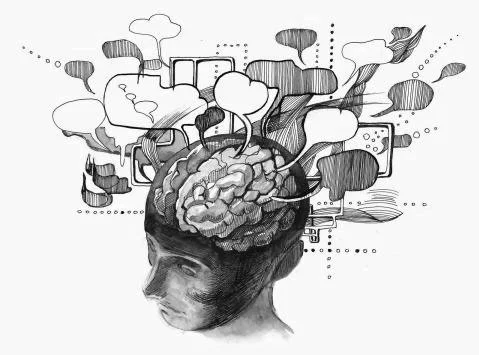why, no, you’re not actually overreacting
Key points:
This is the blog version of my video Why, No, You’re Not Actually Overreacting. If you’re more of a tl;dr kind of person, you may prefer the video.
Despite seeming relatively simple at first glance, reactions are pretty complicated things. And because of their complexities, you’re rarely reacting to what you think you’re reacting to.
While we usually think we’re reacting to what’s happening outside, and that our reaction should be proportional to what’s happening on the outside, it’s actually the exact opposite. We’re always reacting to what’s happening on the inside (the impact of the situation) and our reactions are never proportional to what’s happening on the outside, they’re proportional to what’s happening on the inside.
When we realize this, we realize we need to re-think how we work with our reactions.
The Conversation
Today’s conversation was with a client who came to therapy because she felt she was “over reactive.” Too sensitive, her reactions were over the top or too big for the situation.
Which immediately had me a little skeptical, because - and if you’ve watched any of my other videos, you’ve heard me say this many times - nature doesn’t do anything in vain. If it’s happening, it’s happening for a reason. So if a reaction is bigger than we might expect, we want to start being curious as to why that might be, not just dismissing it as excessive.
Which led us to discussing reactions - what they are, how they happen, and why - spoiler - there’s actually no such thing as “overreacting.”
What do I mean when I say “Reacting”?
So, what are reactions?
In essence, reacting is what your nervous system was designed to do. Reacting is how we engage with and respond to our environment. It’s kind of what differentiates us from rocks.
Simple, right?
The trouble is…
You’re Never Reacting To What You Think You’re Reacting To
For 2 reasons:
You think you’re reacting to what’s happening outside, but you are not, you are always reacting to what’s happening inside, and
What’s happening inside is not a direct reflection of what’s happening outside, it’s reflective of our analysis of what’s happening outside
There’s a lot to unpack there, so, let’s take a closer look at both of those things.
You’re Reacting To The Impact
So, first point - You think you’re reacting to what’s happing outside, but you’re not. You’re reacting to the impact; you’re reacting to the effect what’s happening out there is having in here.
In some sense, this is really obvious, but in daily life, it’s not the way we think about ourselves and the world. I say “I hate traffic.” But that’s not really accurate. I don’t hate traffic. I hate the way traffic makes me feel. I hate feeling confined and trapped and at the mercy of the drivers around me.
My reaction - hating - is actually a reaction to the internal experience - feeling confined and trapped and at the mercy of the drivers around me - not to the traffic.
Our reactions are always about how a situation make us feel, not to the situation itself.
Even if someone punches me in the face, what I react to is the fact that it hurts, not how that person moved their fist through space.
We react to the impact of the situation, not the situation itself.
Reaction = Impact
Reaction ≠ Situation
And it gets more complicated, because - and this brings us to the second point -
The Impact Isn’t Proportional to The Situation
What’s happening inside is not a direct reflection of what’s happening outside. What’s happening inside is reflective of our analysis of what’s happening outside.
We could go through the whole neurological process of how our brain takes in, makes sense of, and then decides how to respond to a thing, but very few people are probably here for that, so we’ll just cut to the moral of that story, which is - when your brain encounters something, it’s always answering the question “what is this like?” Not “what is this?” - “what is this like?”
And how does it answer that question? By going into the archives of the mind and comparing this thing to all the data it’s collected about the world thus far, to figure it out what it’s associated with. What it’s connected to. What it’s most similar to. What it’s like.
Your brain runs a comparative analysis. And when we react, that’s what we’re reacting to - our brain’s assessment of “what is this like?”
Impact = Situation x Results of Brain’s Comparative Analysis
Impact ≠ Situation
So - to recap, we
React to the impact of the situation, not the situation itself (what’s going on in here, not what’s going on out there) and
The impact (what’s going on in here) isn’t proportional to the situation (what’s going on out there). The impact is proportional to our associations with the situation. It’s proportional to how our brain answers the question “what is this like?”
Why does this matter? What does this mean?
Why There’s No Such Thing as “Overreacting”
Well, first, it means there’s no such thing as overreacting.
“Overreacting” means your reaction isn’t proportional to the situation, but we’ve already learned that our reactions are not proportional to the situation, they’re proportional to the impact of the situation, which is proportional to our brain’s assessment of “what is this like?”
Reaction = Impact = Results of Brain’s Comparative Analysis
Reaction = Impact = Brain’s Assessment of “What is this like?”
So there’s no such thing as overreacting. The term “overreacting” comes from a misunderstanding of what you’re reacting to. If you feel like your reaction is bigger than what the situation warrants, it’s because there’s more to that story.
You’re not overreacting, we’re just not seeing the full picture.
And that part that we’re not seeing is everything that’s happening inside, which brings us to the second reason this matters, which is
If It’s Intense, It’s In You
If a reaction is intense, it’s because of what’s happening in here, not what’s happening out there. Remember, we’re always reacting to the impact of what’s happening, we’re reacting to what’s happening inside. That’s what needs our attention.
A colleague of mine likes to say “It it’s intense, it’s you.” And she’s not saying it to dismiss that sometimes there’s also very real stuff going on out there that your needs attention. But that the intensity of the reaction speaks to the impact it’s having inside. And we’re going to be more effective at dealing with whatever needs to be dealt with out there if we’ve taken care of what’s happening inside first. If you’ve flipped your lid (and if you don’t know what that means, I’ll link that video here) or are in fight or flight mode, dealing with this is going to make you much more effective at dealing with that.
So if we’re having an intense reaction, it’s a cue that we need to turn the lens of attention around, from looking out to looking in, so that we can start to get to know the full picture.
That intense reaction is actually alerting us to stuff inside that needs to be healed, because - and this brings us to the third reason this matters -
What’s In Your Memory Archives Matters (In A Big Way)
If what we’re reacting to is ultimately our brain’s comparative analysis, our brain’s assessment of “what is this like?”, then what it’s comparing things to is realllyyy important.
If our memory archives are filled with some toxic stuff, and that’s the assessment matrix our day to day experiences are being run through, we’re probably going to have some big reactions and it can make present day life kind of unpleasant.
Most big reactions are because the brain has connected the present situation with something painful or threatening.
For my client, her “overreactions” were because, when her brain tried to figure out what present day situations were like, all the files it referenced said “you’re a failure,” “you’re not good enough.” Those were the answers that came up in her brain’s assessment of “what is this like?” and that’s what she reacted to.
What the brain is referencing, what it has in it’s memory archives to determine what things are like, is going to determine how we react. If we can heal the toxic stuff in the archives, then the assessment changes and then the reaction changes.
So, how do we do that?
What To Do With Big Reactions
That question is going to take a few more videos to answer, but an important starting point is getting to know the full picture. Understanding what we’re actually reacting to.
If you notice a big or intense reaction, see if you can take that cue to look inwards. Remember you’re not actually reacting to what’s going on out there, you’re reacting to what’s going on in here. See if you can find what that is. RAIN, which I did a video on recently, would be a great practice to use in this situation. The investigate step might start to reveal what’s in the memory archives, what’s being referenced at that moment.
There are also some more specific techniques that can be helpful in understanding our reaction patterns, if that’s of interest, let me know in the comments section below, I’d love to hear from you.







